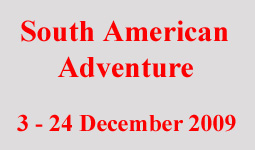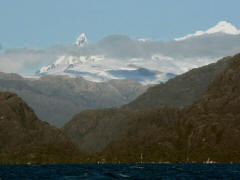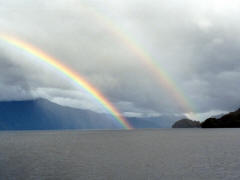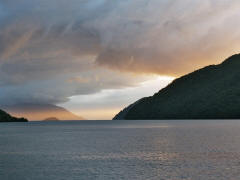Page 1 2 3 4 5 6 7 8 9 10 11 12 13 14 15 16 17 18 INNER PASSAGE Thursday, 17 December. The Veendam must have left the Strait of Magellan around 4:00 a.m. We were not in the open waters of the Pacific, though, but in an inner passage among the many islands on the west coast of Chile. (By the time we got up, we must have been near Isla Shoalon, where the M.S. Santa Leonora was shipwrecked in 1964, but no one called our attention to the hulk as we passed it.) The width of the channel varied greatly as we sailed along. It looked very much like the Beagle Channel except there was a little less snow. This was a day at sea with "scenic cruising" according to our program. It was mostly cloudy but we saw the sun and some blue skies later on. The temperature was in the 40s. Jane was feeling weak and we had breakfast in our room. At 11:00 we went to an interesting lecture, "Fire and Ice," on the geology of South America. The official ship's position at noon had us in the Sarmiento Channel off Puerto Mayne on Isla Evans. Soon after, we left the main channel and did a "fish hook" around to the east and south, entering a closed fiord to visit the Amalia Glacier. We were worried because it started raining at this point. Fortunately it didn't last long. Amalia is a massive tidewater glacier, 21 miles long. It's somewhat unusual in that it's so wide that it seems to flow almost parallel to the shore rather than perpendicular to it. As a result, it has far more of its edge exposed than any other glacier I've ever seen. One of the mountains it partially surrounds is the Reclus Volcano. The ship stayed in front of the glacier for nearly an hour, even maneuvering around so passengers could see it from anywhere on the starboard side. That gave us a variety of pictures as the sun, the clouds, and the fog were constantly changing. The wind was very strong (50 mph) when we first arrived, but as the ship turned, it blocked much of it. Jane came on deck to see the glacier and stayed out for 40 minutes.
Jane and I had dinner in the dining room again and even went to the 8:00 show. The performer was Mark Donoghue, an excellent instrumentalist and singer. Friday, 18 December. Another day at sea. The ship emerged from the Messier Channel into the Gulf of Penas and, in the late morning, continued into the Pacific. It was mostly cloudy, in the mid 50s, with rough seas and intermittent rain. Jane was better and, for the first time, went with me to the Lido for breakfast. To further cheer her up, we went to the jewelry shop on board and I bought her a tanzanite and diamond pendant and earrings as her Christmas present. At 11:00 we went to the Puerto Montt port talk. Then I went to the gym. After lunch we read in the lounge. Late that afternoon the ship left the Pacific and sailed east into the Darwin Channel, then turning north to follow another inner passage. The scenery was much like we'd seen further south, beautiful but with noticeably less snow on the mountains, and the ship was much further away from the shore. We went to the formal dinner in the Rembrandt dining room and to the 8:00 show. It featured Peter Fernandez, an excellent singer with a broad repertoire, including a generous dose of Latin music. Page 1 2 3 4 5 6 7 8 9 10 11 12 13 14 15 16 17 18
Copyright © 2000-2023 DarrellPeck.com All rights
reserved. | |||||





